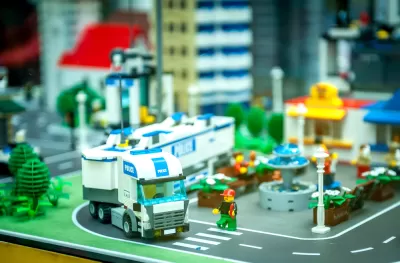A Dutch advocate believes Lego's city sets should reflect streets that prioritize all users. Including bike lanes would be one way for the toy manufacturer to start accomplishing that goal.

Andrew J. Hawkins reports on Lego's curious neglect of bikes: "The streets in Lego’s city sets had space for cars, trains, even tiny storm drains but no designated space for zero-emission, human-powered vehicles like bikes."
"Even worse," adds Hawkins, "it appeared that Lego’s streets were becoming more hostile toward pedestrians over time. As compared to Lego sets from years ago, the cars seem to have grown larger — evolving from four- to six-studs wide — and the roads appeared to be getting wider, while the sidewalks were getting more and more narrow."
A regional councilor from the Netherlands named Marcel Steeman has launched an advocacy campaign o move Lego toward more environmentally friendly representations of the world's built environment.
With the help of Marco te Brommelstroet, an associate professor in urban planning at the University of Amsterdam who tweets under the name Cycling Professor, Steeman submitted two designs to Lego’s “Ideas” project, in which fans are encouraged to submit proposals for new Lego sets. His proposal was simple: more bike lanes.
So far, the efforts has met roadblocks from Lego while winning attention online.

Study: Maui’s Plan to Convert Vacation Rentals to Long-Term Housing Could Cause Nearly $1 Billion Economic Loss
The plan would reduce visitor accommodation by 25,% resulting in 1,900 jobs lost.

North Texas Transit Leaders Tout Benefits of TOD for Growing Region
At a summit focused on transit-oriented development, policymakers discussed how North Texas’ expanded light rail system can serve as a tool for economic growth.

Why Should We Subsidize Public Transportation?
Many public transit agencies face financial stress due to rising costs, declining fare revenue, and declining subsidies. Transit advocates must provide a strong business case for increasing public transit funding.

How to Make US Trains Faster
Changes to boarding platforms and a switch to electric trains could improve U.S. passenger rail service without the added cost of high-speed rail.

Columbia’s Revitalized ‘Loop’ Is a Hub for Local Entrepreneurs
A focus on small businesses is helping a commercial corridor in Columbia, Missouri thrive.

Invasive Insect Threatens Minnesota’s Ash Forests
The Emerald Ash Borer is a rapidly spreading invasive pest threatening Minnesota’s ash trees, and homeowners are encouraged to plant diverse replacement species, avoid moving ash firewood, and monitor for signs of infestation.
Urban Design for Planners 1: Software Tools
This six-course series explores essential urban design concepts using open source software and equips planners with the tools they need to participate fully in the urban design process.
Planning for Universal Design
Learn the tools for implementing Universal Design in planning regulations.
City of Santa Clarita
Ascent Environmental
Institute for Housing and Urban Development Studies (IHS)
City of Grandview
Harvard GSD Executive Education
Toledo-Lucas County Plan Commissions
Salt Lake City
NYU Wagner Graduate School of Public Service




























